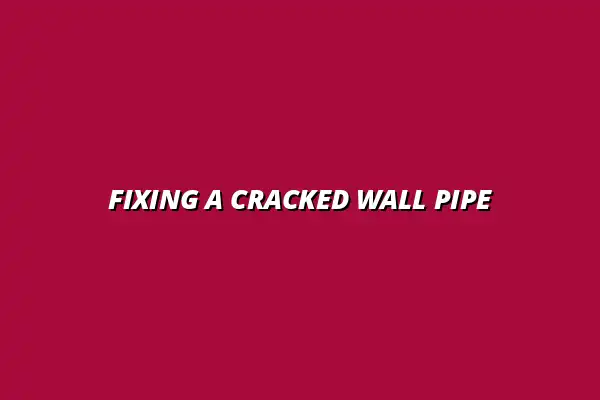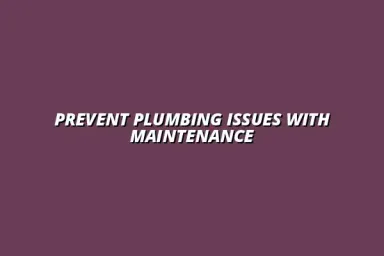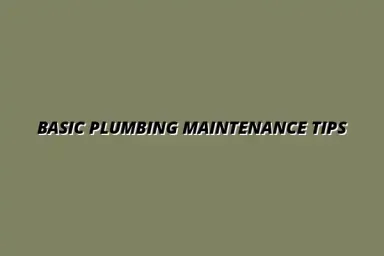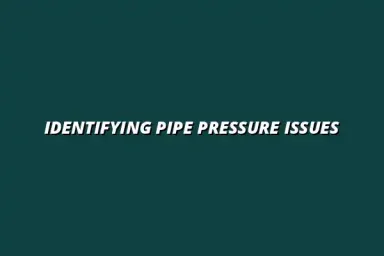Understanding the Issue of Cracked Pipes in Walls
Dealing with cracked pipes in walls can be quite a headache for homeowners. These cracks can lead to leaks, which in turn create more significant damage, such as mold growth and structural issues. Understanding the signs and causes of cracked pipes is essential for effective management and prevention.
It's important to identify these issues early on to avoid costly repairs. Once you know what to look for, you can take the necessary steps to address the problem. Here, we will explore the symptoms and potential causes of cracked pipes to help you stay ahead of any plumbing nightmares!
Identifying the Signs of a Cracked Pipe
Recognizing the signs of a cracked pipe is the first step in preventing extensive damage. You might notice odd smells or sounds in your home that suggest water is escaping from its intended path. Here are some common symptoms of water leaks:
- Unexplained water stains on walls or ceilings
- Increased water bills without additional usage
- Damp or moldy spots in your home
Common Symptoms of Water Leaks
Water leaks can manifest in various ways, so it’s essential to pay attention to your surroundings. For instance, you may find bubbles forming under your paint or wallpaper. These are strong indicators that there’s a leak in the wall, and it should be investigated. If you have a leaking bathroom pipe joint, you can find a helpful DIY guide here to help you fix it.
In addition, watch for an unusual drop in water pressure when using faucets or showerheads. This change can signal that water is escaping through a crack. Being attentive to these signs can save you from major repairs down the line!
Visual Indicators of Pipe Damage
Visual inspection plays a vital role in identifying cracked pipes. Look for any cracks or corroded areas on exposed plumbing. Even small cracks can lead to bigger problems if left unchecked. If you notice any of the following indicators, it might be time to take action:
- Discoloration on walls or ceilings
- Cracks in the wall or foundation
- Warping or buckling of wall materials
If you see any of these signs, it’s best to consult a professional to assess the situation further. A proactive approach can help you tackle issues before they escalate!
Potential Causes of Cracked Pipes in Walls
Understanding what causes pipes to crack is crucial in mitigating future issues. Various factors can lead to cracked pipes, and being aware of these can help you prevent them from occurring. Here are a couple of main causes:
- Changes in temperature that cause pipes to expand and contract
- Soil movement or settling that places stress on underground pipes
Environmental Factors and Their Impact on Plumbing
Environmental factors can significantly impact your plumbing. For instance, extreme weather conditions can cause the ground to freeze and thaw, which may lead to shifts in soil that affect buried pipes. Learning how to prevent frozen pipes this winter is crucial in colder climates. Additionally, heavy rainfall can saturate the soil, creating pressure on pipe joints.
Another environmental consideration is tree roots. As they grow, they can infiltrate pipes and cause cracks or even complete blockages. If you live in an area with invasive tree roots, consider monitoring your plumbing for any disruptions.
Material Deterioration Over Time
Over time, pipes can deteriorate due to age and wear. Older pipes, especially those made from less durable materials, are more susceptible to cracking. Common materials at risk include:
- Iron pipes that rust over time
- Plastic pipes that can become brittle with age
- Lead pipes, which are not only at risk of cracking but also pose health risks
Regularly inspecting your plumbing system can help pinpoint materials that may need replacing. Addressing material deterioration early can save you from bigger headaches in the future!
Preventing Future Cracked Pipe Issues
Taking preventive measures can save homeowners a lot of stress and money when it comes to cracked pipes. By being proactive, you can significantly reduce the chances of water damage in your walls. Here’s how you can maintain your plumbing system and keep it in good shape!
Regular Maintenance Tips for Homeowners
Regular maintenance is key to ensuring your pipes remain strong and functional over time. Simple practices can make a huge difference, so let’s look at a few important tips!
- Insulating Pipes: Wrap pipes in insulation, especially in cold areas, to prevent freezing.
- Checking for Leaks: Regularly inspect your plumbing for any signs of leaks, even minor ones.
- Clearing Debris: Keep gutters and drains clear to prevent water buildup around pipes.
Insulating Pipes to Prevent Freezing
Insulating your pipes can be a game-changer during winter months. This helps to maintain a consistent temperature, preventing pipes from freezing and cracking. You can use foam pipe insulation or heat tape for added warmth.
Make sure to focus on exposed pipes in unheated areas such as basements, attics, or crawl spaces. By doing this, you’ll protect your plumbing against extreme temperature fluctuations and reduce the risk of future problems!
Monitoring Humidity Levels in Your Home
Keeping an eye on humidity levels is another great way to prevent cracked pipes. High humidity can lead to condensation, which may contribute to corrosion and damage over time. Ideally, you should aim for a humidity level between 30% to 50%.
You can use a dehumidifier or air conditioner to regulate humidity levels, especially during humid seasons. Additionally, open windows when the weather permits to allow fresh air in, helping to keep your home dry!
Long-Term Solutions for Pipe Longevity
When it comes to long-lasting pipes, choosing the right materials and installation methods is crucial. With proper decisions, you can minimize the likelihood of issues arising down the road!
- Opting for Durable Materials: Consider using materials like PVC or copper, which are less prone to damage.
- Proper Installation: Ensure that pipes are installed by professionals who follow correct guidelines.
- Regular Inspections: Schedule professional inspections to catch any potential issues early.
Choosing the Right Pipe Materials
Choosing the right materials for your pipes can make a significant difference in their lifespan. Materials like PVC, PEX, and copper are popular for their durability and resistance to corrosion. Understanding the causes of bursting water pipes can help you choose the right material for your needs. Each material has its pros and cons, so consider your home’s specific needs before making a decision!
It's essential to choose materials that suit both your budget and the local climate. Working with a knowledgeable plumber can help you make informed choices that protect your investment.
Best Practices for Installing Pipes in Walls
Proper installation is imperative to prevent future issues with cracked pipes. Make sure pipes are not too tightly packed within walls, as this can lead to increased pressure and potential damage. Adequate space allows for thermal expansion and contraction.
Additionally, using brackets or supports can help secure pipes in place without causing stress. A well-planned installation will pay off in the long run, ensuring your plumbing system remains reliable!
Common Questions About Cracked Pipes in Walls
Understanding common questions can help you feel more prepared when dealing with cracked pipes. Let’s explore some common concerns and the answers to them!
How can I detect hidden leaks behind walls?
Detecting hidden leaks can be tricky, but there are tools and techniques that can help. Early detection can save you from extensive damage and costly repairs!
Tools and Techniques for Leak Detection
Some useful tools for detecting leaks behind walls include:
- Moisture Meters: These devices help measure moisture levels within walls.
- Infrared Cameras: These can detect temperature changes, indicating possible leaks.
- Acoustic Listening Devices: These can help identify the sound of water escaping from a pipe.
Using these tools can make the process much easier and give you peace of mind regarding your plumbing system. If you're dealing with a slow-draining bathroom pipe, addressing it promptly can prevent further damage.
Signs to Watch for in Your Home
Keep an eye out for the following signs that may indicate hidden leaks:
- Water Stains: Look for stains or discoloration on walls or ceilings.
- Unusual Smells: A musty odor may suggest mold due to hidden leaks.
- Increased Water Bills: A sudden spike can signal a hidden leak.
Being vigilant can catch problems before they escalate, saving you time and money.
What are the risks of ignoring a cracked pipe?
Ignoring a cracked pipe can lead to serious consequences over time. The sooner you address any issues, the better your chances of preventing extensive damage!
Long-Term Water Damage Consequences
Water damage from a cracked pipe can lead to:
- Structural Damage: Prolonged water exposure can weaken walls and foundations.
- Increased Repair Costs: The longer you wait, the more expensive repairs can become.
- Property Value Decline: Water damage can reduce the value of your home.
Taking action at the first sign of trouble is essential to prevent these risks! For kitchen sink leaks, a DIY guide can be a helpful resource.
Mold Growth and Health Implications
Another major risk of ignoring a cracked pipe is the potential for mold growth. Mold thrives in damp environments, and it can start to grow within 24 to 48 hours of a leak. It can pose serious health risks, especially for individuals with allergies or respiratory issues.
To protect your home and health, be proactive about addressing any plumbing issues. Regular inspections and prompt repairs can help keep your home safe!
Final Thoughts on Handling Cracked Pipes
Cracked pipes can seem daunting, but with the right approach, you can overcome the challenges they present. By understanding the signs, knowing how to respond, and being proactive in maintenance, you can keep your home safe!
Recap of Essential Steps for Repair and Prevention
Let’s quickly summarize the key points to remember:
- Identify Signs: Look for leaks and water damage.
- Take Immediate Action: Shut off the water and control leaks.
- Maintain Your Pipes: Regularly inspect and insulate pipes.
- Know When to Seek Help: Call a plumber if you're unsure about repairs. For example, if you need a plumber in Billesley, Birmingham, you can find one here.
Summary of Quick Fixes vs. Professional Solutions
While quick fixes can provide temporary relief, professional solutions are often necessary for long-term effectiveness. Understanding the difference can help you make informed decisions about your repairs!
Always weigh the cost and benefits of DIY fixes against professional services. Sometimes, investing in a professional repair can save you more in the long run! Dealing with a leaking water heater? Check out this repair guide.
Encouragement for Proactive Home Maintenance
Finally, I encourage all homeowners to take proactive steps in maintaining their plumbing systems. Regular checks, timely repairs, and preventive measures can make a world of difference!
With a little effort, you can avert many plumbing issues before they even start. Stay informed and keep your home safe from cracked pipes!

 Kiran Almasi
Kiran Almasi

